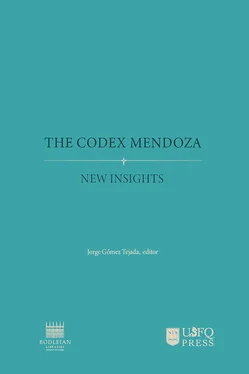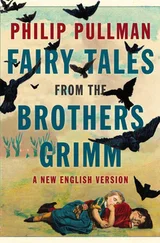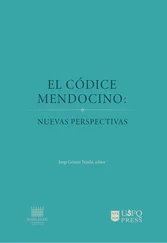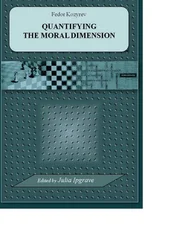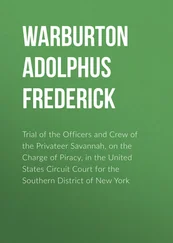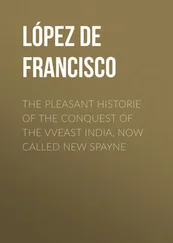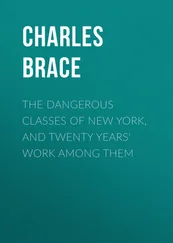In 1925, Jesús Galindo y Villa published the first modern facsimile of the Codex Mendoza. The facsimile was created after a series of photographs was commissioned by Francisco del Paso y Troncoso, who had also served as the director of the National Museum of Mexico. Considered to be of “public value,” the commission had been part of Paso y Troncoso’s project of the recovery of national documents. He initiated this process in 1893, after securing the patronage of Porfirio Díaz.8 Given the preeminence bestowed upon the Codex Mendoza in Orozco y Berra’s work as the inaugural document in an academic serial publication, the role it plays in Peñafiel’s work as both an instrument and a vehicle for a reconstruction of the political and economic geography of the modern Mexican nation based on a pre-Columbian geographic model, and the importance with which Galindo y Villa endows it by marking it as a valuable artifact for the Mexican government, we can see the Codex Mendoza at the forefront of the nationalist Mexican project of the nineteenth and the beginning of the twentieth centuries.
A series of historicist studies, inaugurated with the publication of a new facsimile by James Cooper Clark in 1938, sought to ground the history of the codex in documentary and material evidence. In this facsimile, Clark focuses on two main areas: first, the materiality of the manuscript and, second, the identification of a possible author of its texts. For his analysis of the paper used for the Codex Mendoza, Clark (1938) uses the 1909 Briquet Catalogue. The evidence Clark discovered allowed him to safely date the production of the manuscript to the middle of the sixteenth century, thus providing the evidence necessary to historically ground the manuscript. Likewise, his discussion of the pigments used in the Codex Mendoza, which he based on the list of native pigments found in Book XI of Sahagún’s ([1578] 1979) Florentine Codex, constituted the first study that understood the manuscript as a product of the ingenuity of indigenous artists. In his attempt to name an author of the Codex Mendoza, Clark bases his work on the interpretation of a calligraphic gesture with which the author of the manuscript’s texts concludes folio 71v. According to Clark, the aforementioned gesture was the letter “J” and, as a result, Clark attributes the texts in the Codex Mendoza to Martín Jacobita, one of Sahagún’s collaborators in Tlatelolco.
The same year, two Mexican scholars published studies of the manuscript which, just as Clark had, focused on the authorship both of the texts and pictures in the Codex Mendoza. The first of these, Silvio Zavala (1938, 59–75) identified tlacuilo Francisco Gualpuyogualcal as the creator of the pictures in the codex. Zavala’s claim was based on a 1547 letter by encomendero Jerónimo López addressed to Viceroy Antonio de Mendoza, which had previously been published by Francisco Fernández del Castillo in 1927. The apparent connection Zavala’s study made between the manuscript and the viceroy helped substantiate what until then had been a hypothesis lacking documentary support. This claim, however, has been previously questioned, first by Nicholson in 1992 and then by me in 2012, using both physical and contextual evidence. Although the issue of patronage and commissioning of the Mendocino is the subject of another chapter in this volume, it is worth discussing briefly at this point the text Zavala (1938, 59) referred to in order to connect the manuscript to the viceroy and mention both its contribution and consequences for the construction of the history of the Mendocino:
It must have been approximately six years ago when entering one day in the house of an Indian called Francisco Gualpuyohualcal, a master of painters, I saw in his power a book with parchment covers. When I asked him what it was, he showed it to me in secret and told me that he was making it by command of Your Lordship. In it he was going to depict all the land since the foundation of this city of Mexico and all the lords that had ruled it until the arrival of the Spaniards, and the battles and clashes that they had, and the conquest of this great city, and all the provinces that it ruled and everything that was her subject, and the division of the peoples and provinces that Moctezuma did in favor of the main lords of this city, and of the tribute that each one of the encomienda-owners paid to him from the towns that he had, and the design of each one of these divisions, and how he designed the towns and provinces for this purpose, and whence came these new services, both personal and domestic, and it was not something that the Spaniards enforced once again and, after this, the division that the Marques del Valle did of said peoples and provinces and all of those who ruled.
It is evident that the Codex Mendoza lacks some of the cardinal elements López references. We know from Bruce Barker-Benfield’s study of the paper and binding of the manuscript (included in this volume) that there is no internal evidence that the manuscript was bound before the 1600s. Likewise, the contents of the manuscript López describes—including the battles between Spaniards and the Mexica, the delineation (urban planning) of towns and provinces, or the apportioning of these and its contributions amongst the Tenocha nobility—do not reflect that of the Codex Mendoza. Finally, while we know through several sources that the viceroy wished to compile information on New Spain, such as the letters that Mendoza sent to his brother, don Diego, and which were published by Gonzalo Fernández de Oviedo in his Historia natural y general de las Indias, he had not merely commissioned texts to send to Spain, but hoped to author something which surpassed the reach and scope of the Codex Mendoza. Fernández de Oviedo ([1532] 1959) twice quotes the viceroy’s writings on the history of Mexico,
He [Viceroy Mendoza] writes to his brother don Diego that the foundation of Temistitan occurred in this manner: At the time of the war between the Mexicans and the Tlaxcalans came from the north in direction to the Province of Panuco, a captain named Orchilobos together with four hundred well-trained men with gold and silver weapons. They invervened in the war in aide of the Mexicans and by their effort and labor they were victorious. And, realizing that the appropriate place for settling down was in a nearby lake, which had a thin entrance of small mounds that lead to a small island or rock that was almost at the center of the lake, he bagan to inhabit the place with his people. He thus made a small stone tower that afterwards became Orchilobos’s Templo Mayor, consecrated to his name, and thenceforth little by little he dominated and subjugated the neighboring towns until he became lord of Mexico, and in nearby provinces he sent settlers until the population grew to become a city. (4:103-4)
… In regards to the report that you say they sent you from Venice and which I had originally sent to His Majesty of some things of this land, and that among them I said that the Mexicans came from Perú, it is true that I have written some things that I seemed to notice; but not this one, because I am of the contrary opinion and I think that they came from the north. Ancient buildings and names of the places through which they came attest to this. … I have tried to collect a report of the things of this land and be very particular about it and I have found a diversity of opinions because since there were many lords in every province, they all tell things in their own manner. I am collecting and verifying them and once I have done so I will send them to you; because it seems to me that it would be a very shameful thing if I sent you a relation of which you deemed me to be the author and it were not but completely truthful. The things of this land are not so little that you will not be able to make a book from them, and the book will not be small either, because even though Moctezuma and Mexico have become famous among us, Caçonçi of Mechuacan was no less of a lord, just as were others who did not recognize either one or the other. (4:117-18)9
Читать дальше
